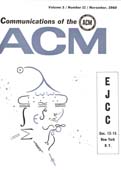November 1960 - Vol. 3 No. 11

Features
The assignment problem is formulated and briefly discussed. An efficient algorithm for its solution is presented in ALGOL code. An empirical relation between solution time and the size of the problem is given, based on extensive experiments carried out on a digit computer.
Compilation for two computers with NELIAC
NELIAC, a compiler based on ALGOL, was developed at the U. S. Navy Electronics Laboratory, San Diego, California, as a “bootstrap” compiler for the Remington Rand Univac COUNTESS computer. This compiler was used to generate a version of itself which, running as a COUNTESS program, generated machine code for the Control Data Corporation CDC-1604 computer. This second compiler was then used to generate a version of NELIAC for the CDC-1604. All three versions of NELIAC accepted essentially identical input language.
Least squares fitting of a great circle through points on a sphere
version of itself which, running as a COUNTESS program, generated machine code for the Control Data Corporation CDC-1604 computer. This second compiler was then used to generate a version of NELIAC for the CDC-1604. All three versions of NELIAC accepted essentially identical input language.
Over all computation control and labelling
The primary function of computer installation is (as everyone knows) to solve useful problems. The programs that accomplish such solutions are called production programs, and when they are applied to a particular set of data and run on the computer the computer is engaged in a production run.
A simple technique for coding differential equations
A computer program that will solve an arbitrary system of first-order differential equations according to some conventional numerical method may be considered to have two distinct parts. The main program performs all of the operations of input-output, initialization, choice of step-size, and actual solution of the equations. This part of the program is independent of the functional equations relating the derivatives to the variables. A subsidiary program evaluates the derivatives according to the given functional relationships, and this subprogram or subroutine has to be written for each new system of equations [1].
An estimation of the relative efficiency of two internal sorting methods
This report concerns the IBM 705, models I and II. It is a study of the machine time required by two internal sorting methods, the conventional two-way merge, and a form of the binary search, which is due to D. Mordy, of the IBM Corporation. In particular, estimates are derived for the more time-consuming machine operations of comparison of keys, loading of keys into accumulator storage, and transmission of tags. The first two operations arise in both methods; the last is peculiar to the binary search. If the exclusion of other ancillary program steps from the estimation of machine times may be regretted from a purely practical point of view, some of the intermediate estimates may be of interest in a more theoretical context.
On a recent motor trip through Mexico, the writer came across an adding device which was referred to as a sumador chino (Chinese adder). A survey of the more available literature on the history of mathematics and on instruments of calculation has uncovered no reference to such a device. The purpose of this communication is to enlist the help of other members in bringing to light whatever may be known concerning the evolution and present status of the sumador chino.
Character scanning on the IBM 7070
One general requirement in the construction of symbol manipulators and automatic programming systems is the need to scan a line of information, usually from left to right, and to break down or subdivided this line into words, phrases or some form of subgrouping. Assuming a natural or free form was allowed in the composition of the line, it will be necessary to examine in sequence each character of the line and, depending on the syntactical rules in force, accumulate characters into a word until a separator is recognized. For example, consider breaking down AX, BX, CX on the basis of the comma.



